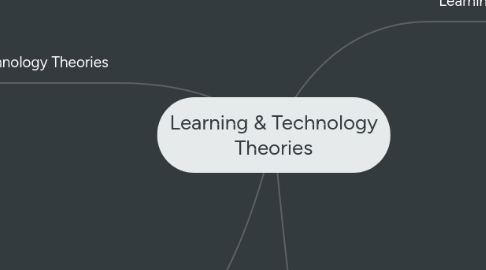
1. Learning Theories
1.1. Constructivism
1.1.1. actively engaged students that collaborate, critically think, employ reflection
1.1.2. learning is built and modifies previous knowledge
1.1.3. teachers guide students to find their answers
1.1.4. the classroom setting is inquiry based, reflective, collaborative, and active
1.1.5. knowledge is adjusted by assimilation and accomodation
1.2. Connectivism
1.2.1. increased emphasis on the capacity to know more
1.2.2. learning occurs when knowledge connects with the right people in the right context
1.2.3. attempts to address the challenges of organizational knowledge and transference, unlike other theories
1.2.4. learning occurs when connections between ideas, fields, and concepts are made
1.2.5. essentially, the integration of principals explored by chaos, network, complexity, and self-organization theories
1.2.6. teachers guide students to differentiate good and current information from bad and outdated information
1.3. Cognitive Load
1.3.1. we can hold about seven (give or take) chunks of disconnected information
1.3.2. working memory has very limited capacity and refers to our thinking/knowledge
1.3.3. our brain processes information and sorts it into visual or phonetic scratchpads
1.3.4. connections must occur between existing knowledge and memory in order to be stored for long periods of time to achieve learning
1.3.5. teachers must be wary that they do not over-process student schemas
1.4. Behaviorism
1.4.1. behaviorism is a function of change and behavior, as a result of stimuli
1.4.2. learning is a complex process of responses
1.4.3. this method has shown promising response from children with special needs
1.4.4. teaching methods include modeling and breaking tasks into manageable tasks to maximize clarity
1.4.5. effective teaching is influence by both positive and negative reinforcement
2. Technology Theories
2.1. SCOT
2.1.1. Social Construction of Technology
2.1.1.1. the idea that rather than technology driving humans, our actions change technology
2.1.1.2. it is a methodology; SCOT contains principles and steps for determining the cause of a technological success or failure
2.1.1.3. a drawback is that it fails to account for consequences of technology
2.1.1.4. can be used to describe why a technology is accepted or rejected by the social world
2.2. Media Ecology
2.2.1. looks at how technology influences society's feelings and perceptions
2.2.2. defined as the study of complex communication systems as environments
2.2.3. focuses on how media environments with technology and communication lead human affairs
2.2.3.1. contrary to SCOT; humans are directly affected by technology
3. TPACK
3.1. focuses on the knowledge interplay of Pedagogy, Content, and Technology
3.1.1. Students will greatly benefit from teaching when all three domains are seamlessly interwoven in a lesson
3.1.2. Technological knowledge refers to the ability to use a computer, software, etc.
3.1.3. Content knowledge includes the subject that being conveyed to students
3.1.4. Pedagogy refers to the ability to teach - essentially the transfer of knowledge to students
3.2. essentially a set of guidelines that teacher
4. Philosophy of Teachnology
4.1. this refers to a teacher's ideology about how technology can be incorporated into a classroom setting
4.1.1. teachers can develop statements which are evaluated over time, reflecting views on the role of technology in the learning and teaching process
4.1.1.1. it is similar to the philosophy of teaching in this way
4.1.2. we can encourage students to approach technology and encourage them to incorporate it in their learning
